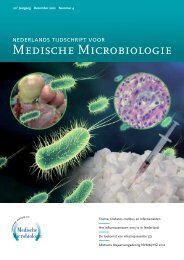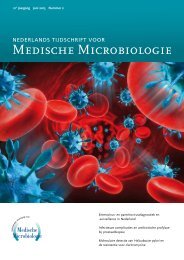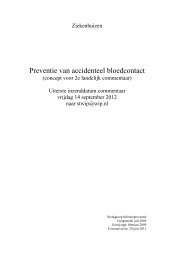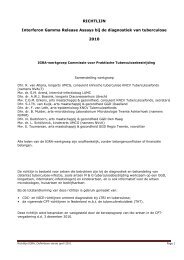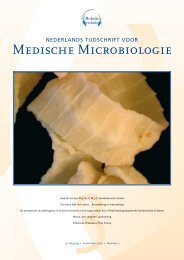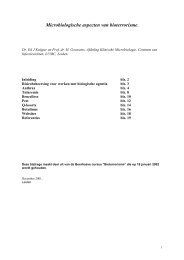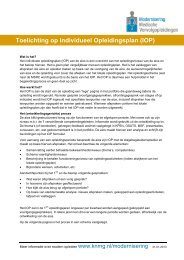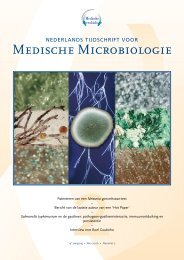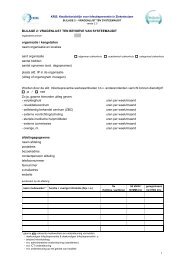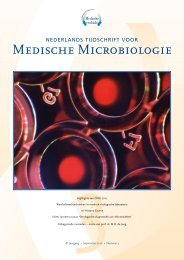S1 De voorjaarsbijeenkomst van de Nederlandse ... - NVMM
S1 De voorjaarsbijeenkomst van de Nederlandse ... - NVMM
S1 De voorjaarsbijeenkomst van de Nederlandse ... - NVMM
You also want an ePaper? Increase the reach of your titles
YUMPU automatically turns print PDFs into web optimized ePapers that Google loves.
2. Hamilton HL, Schwartz KJ, Dillard JP. J Bacteriol<br />
2001;183:4718-26.<br />
3. Hamilton HL, Dominguez NM, Schwartz KJ, Hackett<br />
KT, Dillard JP. Mol Microbiol 2005;55:1704-21.<br />
O117<br />
epi<strong>de</strong>miology of erythema migrans and tick bites, and<br />
infection of ticks with Borrelia<br />
A. Hofhuis 1 , W. <strong>van</strong> Pelt1 , D.W. Notermans1 , F. Borgstee<strong>de</strong>2 ,<br />
J. <strong>van</strong> <strong>de</strong>r Giessen 1<br />
1Centre for Infectious Disease Control, National Institute<br />
for Public Health and the Environment (RIVM), Bilthoven,<br />
2Central Veterinary Institute, Lelystad<br />
Since Lyme disease is not notifiable in the Netherlands,<br />
retrospective studies have been carried out to <strong>de</strong>termine<br />
the occurrence of tick bites, erythema migrans and Lyme<br />
disease. In 1995, 2002 and 2006, all general practitioners<br />
in the Netherlands (approximately 8000) were asked to<br />
complete a postal questionnaire on tick bites and erythema<br />
migrans case-patients seen in the previous year. Based on<br />
these survey responses, the inci<strong>de</strong>nce of erythema migrans<br />
consultations was estimated at 39 per 100,000 population<br />
in 1994, which doubled to 74 per 100,000 in 2001, and<br />
tripled to 103 per 100,000 in 2005. The inci<strong>de</strong>nce of tick<br />
bite consultations increased from 191 per 100,000 in 1994<br />
to 372 per 100,000 in 2001, and continued to increase to<br />
446 per 100,000 in 2005. The largest increase in tick bites<br />
and erythema migrans was seen in the south and northeast<br />
of the country, and several locations along the coast in the<br />
west. Statistical analysis of ecological risk factors by local<br />
government showed that the increase in tick bites and<br />
erythema migrans was associated with increases in tourism,<br />
places with horse riding facilities, and new forest in urban<br />
regions. Annual counts of hospital admissions, obtained<br />
from a database of the Dutch National Medical Register,<br />
coinci<strong>de</strong>d geographically with locations where physicians<br />
were consulted for tick bites and erythema migrans. The<br />
estimated annual number of hospital admissions for Lyme<br />
disease increased gradually from 118 patients in 1991 to 233<br />
patients in 2002. From thereon, the number of patients<br />
increased strongly to 517 patients in 2006. To study the<br />
tick <strong>de</strong>nsity and the dynamics of Borrelia infection in ticks<br />
in different habitats, ticks were collected from the field by<br />
dragging a blanket in four habitat areas in the Netherlands:<br />
dunes, heather, forest, and a city park. Results from 2000<br />
to 2004 showed that the lowest tick <strong>de</strong>nsity was observed<br />
in the heather area the highest tick <strong>de</strong>nsity was found in<br />
the dune area. Tick <strong>de</strong>nsities and infection rates of ticks<br />
varied between years and types of vegetation, 0.8% to 11.5%<br />
of the collected ticks were infected with Borrelia burgdorferi<br />
sensu lato. In addition, other potentially pathogenic microorganisms<br />
like Anaplasma/Ehrlichia (1%-15%), Rickettsia<br />
Ned Tijdschr Med Microbiol 2008;16:Supplement<br />
S46<br />
(5%–60%), and Babesia (0%-1%) were also found, which<br />
poses an increasing but unknown threat for public health.<br />
To gain more insight in the infection risk of Borrelia and<br />
other tick borne pathogens, a prospective study started<br />
in 2007: the National Tick bites study. The study <strong>de</strong>sign<br />
inclu<strong>de</strong>d approximately 160 general practices throughout<br />
the Netherlands. Patients with an erythema migrans or<br />
a tick bite are enrolled into the study to gain insight in<br />
the risk of transmission of tick-borne micro-organisms<br />
as <strong>de</strong>tected in the collected ticks from these patients to<br />
humans and to observe their serological and clinical<br />
outcomes. As data collection is ongoing in 2008, only<br />
preliminary results will be presented.<br />
O120<br />
Where is the origin of the Cryptococcus gattii Vancouver<br />
Island outbreak?<br />
F. Hagen 1 , E.E. Kuramae 1 , M. Bovers 1 , D.J.C. Gerits 1 ,<br />
C.H.A. Gerritzen 1 , W. Meyer 2 , T. Boekhout 1<br />
1<br />
<strong>De</strong>pt. of Yeast Research, CBS Fungal Biodiversity Centre,<br />
Utrecht, 2Westmead Hospital, Sydney, Australia<br />
The pathogenic basidiomycetous yeast Cryptococcus gattii<br />
may cause a life-threatening disease of the central nervous<br />
system, lungs and skin in humans and animals. C. gattii is<br />
found mainly in tropical and sub-tropical regions of South<br />
America, Africa, Asia and Australia where it is en<strong>de</strong>mic.<br />
Recently, a cryptococcosis outbreak in both humans and<br />
animals occurred on Vancouver Island (British Columbia,<br />
Canada) (Kidd et al., PNAS 101, 2004). This outbreak was<br />
shown to be caused by a rare genotype of C. gattii (AFLP6A<br />
or RAPD VGIIa). The objective of this study was to find the<br />
origin of the outbreak isolates.<br />
A selection of thirty-four C. gattii outbreak isolates and<br />
ninety C. gattii reference strains were analysed by AFLP.<br />
The six different AFLP fingerprint analyses were carried<br />
out in duplicate. Reproducible marker fragments were used<br />
for population genetic analysis. In addition, polymorphic<br />
fragments from the AFLP analyses were used to <strong>de</strong>velop a<br />
multilocus sequence typing (MLST) approach.<br />
Fraser et al. (Nature 437, 2005) suggested that the<br />
Vancouver Island outbreak isolates originated from<br />
Australia. However, our results based on AFLP and MLST<br />
analyses show that the outbreak isolates originated from<br />
South America. South American isolates were found to be<br />
ancestral to Australian and Asian isolates as well.<br />
References<br />
- Kidd SE, Hagen F, Tscharke RL, Huynh M, Bartlett<br />
KH, Fyfe M, L.et al. A rare genotype of Cryptococcus<br />
gattii caused the cryptococcosis outbreak on Vancouver<br />
Island (British Columbia, Canada). Proc Natl Acad Sci<br />
USA 2004;101:17258-63.




